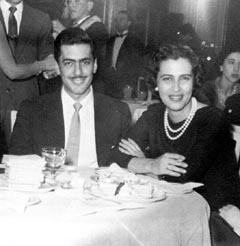 I think that it's time for part three of our study guide!
I think that it's time for part three of our study guide! Monday's presentations were as follows:
Grant's presentation on Jules Verne, focusing on Twenty Thousand Leagues Under the Sea
Ismail's presentation applying Erikson's theory of development to Death of a Salesman
Pamela's presentation on Cuban poet and painter Armando Vallardes
Inhae's presentation on the Brothers Grimm
Liliana's presentation on Nobel prize winner Mario Vargas Llosa
The picture below is of Vargas Llosa with his first wife, Julia.
 We also discussed the ballad, a form present in both poetry and song.
We also discussed the ballad, a form present in both poetry and song.Here are a few more links for you:
In the 1960s, Simon and Garfunkel put E.A. Robinson's poem "Richard Cory" to music. Here is a link to the poem although it is in our anthology:
Ballad: a relatively short narrative poem, written to be sung, with a simple and dramatic action. The ballads tell of love, death, the supernatural, or a combination of these. Two characteristics of the ballad are incremental repetition and the ballad stanza. Incremental repetition repeats one or more lines with small but significant variations that advance the action. The ballad stanza is four lines; commonly, the first and third lines contain four feet or accents, the second and fourth lines contain three feet. Ballads often open abruptly, present brief descriptions, and use concise dialogue.The folk ballad is usually anonymous and the presentation impersonal. The literary ballad deliberately imitates the form and spirit of a folk ballad. The Romantic poets were attracted to this form, as Longfellow with "The Wreck of the Hesperus," Coleridge with the "Rime of the Ancient Mariner" (which is longer and more elaborate than the folk balad) and Keats with "La Belle Dame sans Merci" (which more closely resembles the folk ballad).
 Tuesday we saw the following presentations: Hubert's presentation on Dmitri Shostakovich's Fifth Symphony, Wajiha & Jonathan's presentation on Eminem's "Mockingbird," Aurelie's presentation on Victor Hugo's "Demain des l'Aube," and Dexter's presentation on the Beijing production of Death of a Salesman.
Tuesday we saw the following presentations: Hubert's presentation on Dmitri Shostakovich's Fifth Symphony, Wajiha & Jonathan's presentation on Eminem's "Mockingbird," Aurelie's presentation on Victor Hugo's "Demain des l'Aube," and Dexter's presentation on the Beijing production of Death of a Salesman. 

We looked at some other forms of poetry. The first is the tanka or waka, a very concise form from Japanese literature. It is actually quite old, dating from the 700s CE (or the 8th Century), and one of its leading lights was a woman, Ono no Komachi who lived during the 9th Century. At that time, upper-class Japanese women were encouraged to pursue literature in Japanese. The men, on the other hand, read and wrote Chinese. Here is the link we looked at:
http://www.gotterdammerung.
Her picture is above. She commonly appears in Japanese prints as an archetypal poetess and seductive woman.
One poem was translated by Arthur Waley, a noted translator from the early 20th century. Two were translated by Jane Hirschfield, an American poet, and Aratani Mariko, a Japanese poet.
The second is the bop, a new form developed by African-American poet Afaa M. Weaver.
http://www.poets.org/
http://www.poets.org/
Scroll down this link to find another example of the bop poem:
http://jstheater.blogspot.com/
I've also attached Evelyn N. Alfred's bop poem, "flashes: a bop for bix b." Enjoy!
We listened to another one of Afaa M. Weaver's poems. This one is not a bop, and it takes place in Taiwan:
http://www.poets.org/
The picture below is of Taipei's most famous "night market."
 We finished up with the following presentations:
We finished up with the following presentations:Joe & Lizzy on 1950s pop culture
Nahom on the American Dream & Death of a Salesman
Clifford on music as literature
Karen, Shennekia, & Jason on song lyrics as poetry
You may also watch Mauricio's video on Cesar Vallejo, the Peruvian poet, here:
Thanks for a great semester!





Attachment: flashes.docx
8 comments:
I recently thought of Jules Verne..looks like a nice class. Am wanting to
make a book on Blurb...but although I initially am a member with a
password etc the actualization is still not abilified ...stumbling along in it.
I recently spoke to Nina but cannot visit...my son who is now 50 on this
Friday is celebrating at the Ritz Carlton Hotel in NYC..invited Nina but she
is not able to attend....am working at a little store in Somerville,
Creative Union, which is part of www.outsidethelinesstudio.com (might be
.org) best wishes, tamara
Yikes! Time is passing. How is Nina these days? Hope your son's party is fun.
it is a trip to a foreign land...will let you know.I like your photo with you mom.
Yes, that is one of her better photographs. My dad took it.
say hello and best regards to both you and Ethan. Stacie gives reports of how D.C. evening
life is like and some visits to your neck of the woods. I truly enjoy the website on worldlit.
Am working within myself as to the connections between Jules Verne's 20.000 leagues under
the sea and the scottish ballads. particularly, Richard Corey and the McCallum group...great
music.
Thanks :)
very interesting and nice picture of vargas
Thanks, Lili :)
Post a Comment